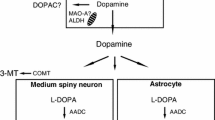Summary
Intravenous or oral application of L-Dopa increased not only the plasma level but led at the same time to an improvement of the kinetic behaviour. A combined intravenous or oral administration of L-Dopa and the decarboxylase inhibitor Ro 4-4602 stop the damage of this peripheral L-Dopa-metabolism for the most part and therefore a higher L-Dopa-plasma-level is reached and the increase lasts longer.
A reduction of L-Dopa dosages is the clinical result. A potentiation of clinical and biochemical effects we found in three of ten failures after a medication of L-Dopa plus amantadine-sulfate-infusion. Two of the ten failures showed a clinical deterioration and also diminished L-Dopa-plasma levels after L-Dopa plus amantadine-sulfate-infusions; five of ten failures demonstrated no change in the plasma level after application of amantadine-sulfate-infusions plus L-Dopa.
For producing kinetic effects a sufficient availability of L-Dopa in plasma is necessary and a sufficient utilization in the brain has to be. In cases of akinetic crisis a combined infusion of L-Dopa plus amantadine-sulfate is a vital indication.
Similar content being viewed by others
References
Andén, N.-E., A. Carlsson, andJ. Kerstell: Oral treatment on parkinsonism. Acta Med. Scand.187, 247–255 (1970).
Anton, A. M., andD. F. Sayre: The distribution of Dopamine and Dopa in various animals and a method for their determination in diverse biological material. J. Pharmacol. Exp. Therap.145, 326 (1964).
Barbeau, A.: L-Dopa therapy in Parkinson's disease. Canad. med. Ass. J.101, 791–800 (1963).
Bernheimer H., W. Birkmayer, andO. Hornykiewicz: Verteilung des 5-Hydroxytryptamins im Gehirn des Menschen und sein Verhalten bei Patienten mit Parkinsonsyndrom. Klin. Wschr.39, 1056–1059 (1961).
Birkmayer, W., andO. Hornykiewicz: Der L-Dioxyphenylalanin-(L-Dopa-)Effekt bei der Parkinson-Akinese. Wien. Klin. Wschr.73, 787–788 (1961).
Birkmayer, W.: Failures of L-Dopa therapy in L-Dopa and Parkinsonismus. (Barbeau, A., H. Fletcher, andMcDowell, eds.), pp. 12–16. Philadelphia: F. A. Davis Comp. 1970.
Birkmayer, W.: Die Bedeutung des Monoamin-Metabolismus für die Pathologie des extrapyramidalen Systems. Ars Med. (Zürich)57, 814–825 (1967).
Birkmayer, W., andM. Mentasti: Weitere experimentelle Untersuchungen über den Catecholaminstoffwechsel bei extrapyramidalen Erkrankungen. Arch. Psychiat. Nervenkr.210, 29–35 (1967).
Cotzias, G. C., P. S. Papavasiliou, andR. Gellen: Modification of Parkinsonism: chronic treatment with L-Dopa. New Engl. J. Med.250, 337–345 (1969).
Danielczyk, W., andJ. J. Korten: Die Wirkung von Amantadin HC1 allein und in Kombination mit L-Dopa bei Morbus Parkinson. Med. Mschr.25, 472–479 (1971).
Ehringer, H., andO. Hornykiewicz: Verteilung von Noradrenalin und Dopamin im Gehirn des Menschen und ihr Verhalten bei Erkrankungen des extrapyramidalen Systems. Klin. Wschr.38, 1236–1240 (1960).
Geissbühler, F., J. Constantinidis, J. J. Eisenring, M. Krassvieritch, G. Janniotis, andR. Tissot: Parkinsonism and Metabolism of Dopa in Plasma. Effect of a Decarboxylase Inhibitor. Clin. Acta33, 111–115 (1971).
Hare Ta, B. Beasley, R. Chambers et al.: Plasma and urinary levels of dihydroxyphenylalanine (Dopa) and other amino acids in L-Dopa treated patients with Parkinson's disease. Fed. Proc.29, 414 (1970).
Hinterberger, H., andC. J. Andrews: Catecholamine Metabolism during oral administration of Levodopa. Arch. Neurol.26, 245–252 (1972).
Morgan, J. P., J. R. Bianoline, H. E. Spiegel, N. J. L. Rivera-Calimlin, andR. M. Hersey: Metabolism of Levodopa in patients with Parkinson's disease. Arch. Neurol.25, 39–43 (1971).
Muenter, M. D., andG. M. Tyce: L-Dopa Therapy of Parkinson's Disease: Plasma L-Dopa concentration, Therapeutic Response and side effects. Mayo Clin. Proc.46, 231–239 (1971).
Parkes, J. D., G. Curzon, P. J. Knott et al.: Treatment of Parkinson's Disease with Amantadine and Levodopa: Lancet 29 May, 1083–1087 (1971).
Pletscher, A., G. Bartholini, K. F. Gey, andA. Jeni: Die biochemischen Grundlagen fur die Behandlung des Parkinson-Syndroms mit L-Dopa. Schweiz. Med. Wschr.100, 797–804 (1970).
Rinne, U. K., V. Sonninen, andT. Siirtola: Treatment of Parkinson's Disease with L-Dopa and Decarboxylase Inhibitor. Z. Neurol.202, 1–20 (1972).
Rivera-Calimlin, L., C. A. Dujovne, J. P. Morgan et al.: L-Dopa treatment failure: Explanation and correction. Brit. Med. J.4, 93–94 (1970).
Tissot, R., G. Bartbolini, andA. Pletscher: Drug-induced changes of extracerebral Dopa Metabolism in Man. Arch. Neurol.20, 187–190 (1969).
Author information
Authors and Affiliations
Rights and permissions
About this article
Cite this article
Birkmayer, W., Danielcyk, W., Neumayer, E. et al. L-dopa level in plasma, primary condition for the kinetic effect. J. Neural Transmission 34, 133–143 (1973). https://doi.org/10.1007/BF01244666
Received:
Issue Date:
DOI: https://doi.org/10.1007/BF01244666




